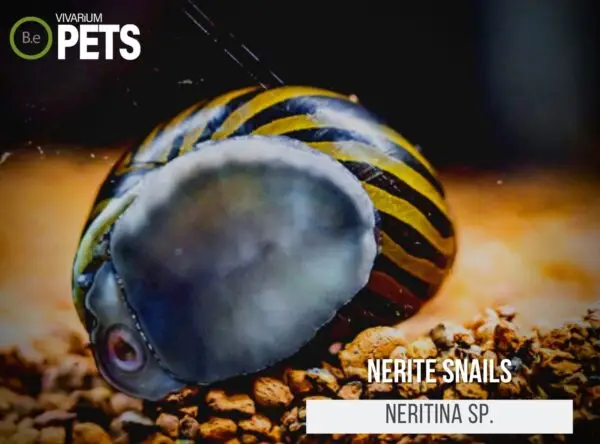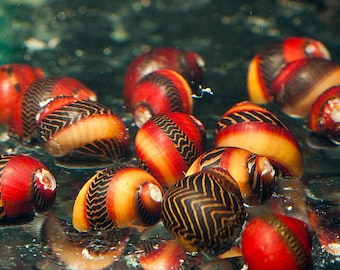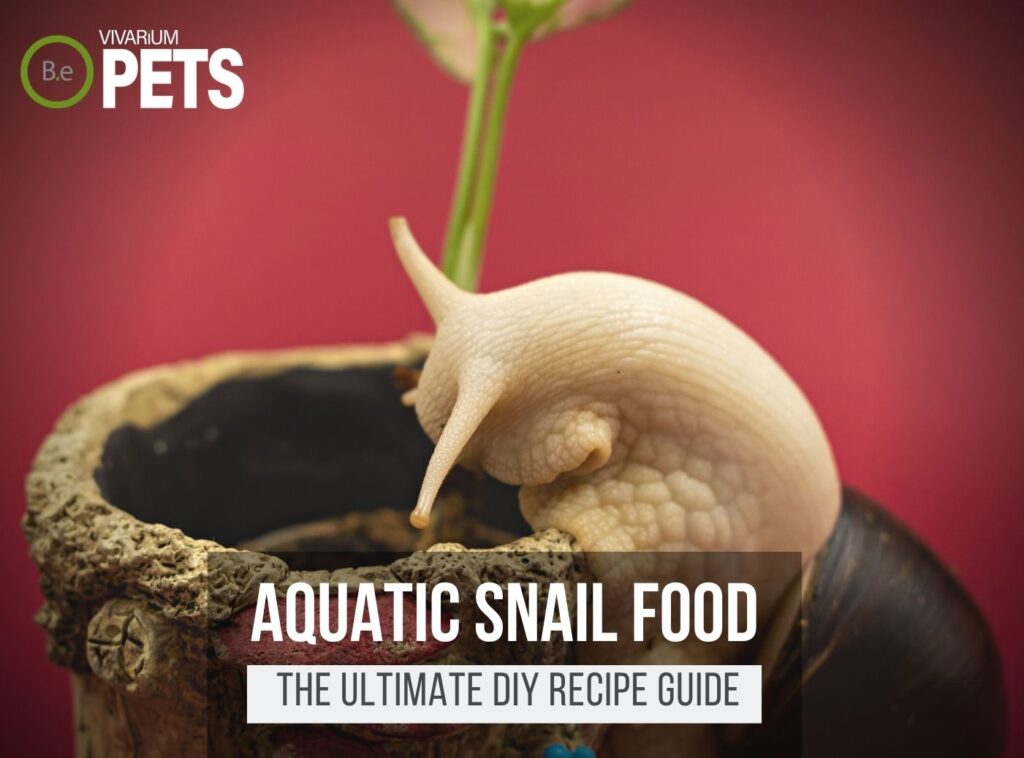If today’s article makes you think of Pixar movies, that’s because it will be about Nerite Snails which is what the movie Turbo got its inspiration from.
These friendly and easy-to-care-for aquarium snails can brighten up any tank with their vibrantly-colored shells and fast-paced personalities.
In this guide, we’ll provide you with all the information you need to know about Neritina species care and help set you up for success in the long run.
Read on to learn more about what it takes to be a great racing snail owner!
| Characteristics: | |
|---|---|
| Common Name | Nerite Snail |
| Family Name | Neritidae |
| Scientific Name | Neritina sp. |
| Use | Cleaning, Aerating Soil, Pets |
| Temperament | Non-aggressive |
| Lifespan | 1-2 Years |
| Diet | Omnivorous |
| Adult Size | 1.3 to 2.5 cm |
| Breeding Type | Egg Layer |
| Care Level | Easy |
| Minimum Tank Size | 5 Gallons |
| pH | 7.0-8.0 |
| Hardness | Hard |
| Temperature | 65 to 82°F |
What Are Nerite Snails?
The Nerite Snail, scientifically known as Neritina sp., is a species of aquatic gastropod belonging to the family Neritidae.
Commonly referred to as nerites, these freshwater snails are native to tropical and subtropical habitats and can be found in Africa, Asia, and Europe.
Nerites come in an array of beautifully patterned exteriors with a variety of colored shells.
They are popular in home aquariums and can provide many useful benefits to your tank!
What Do Nerite Snails Look Like?
These small freshwater mollusks come in a variety of colors and shell patterns.
The most common colors for Neritina sp. are brown, black, yellow, and red, although they can also come in shades of purple, orange, and even blue.
Depending on the species, Nerite Snails can range in size from ¼ inch to 1 inch in shell length.
They have an oval-shaped shell that is composed of whorls, which are spiral patterns often used in mollusk shells.
Nerite Snails also have an operculum, which is a hard plate that covers the entrance to the shell.
This operculum helps the snail keep its body safe and secure when it feels threatened or when the water conditions become unsuitable.
Benefits Of Using Nerite Snails
Neritina sp. is a great addition to any freshwater vivarium!
Not only are they visually striking with their distinctively shaped and brightly colored shells, but they are also incredibly helpful when it comes to cleaning.
They are considered “cleanup crew” members in the aquatic enclosure world and will actively feed on the waste and algae that accumulate in the tank, helping to keep the water clean and healthy.
Nerite Snails are also low-maintenance and don’t require a lot of attention or care to stay healthy.
Not only will they help to keep your tank sparkling clean but can even help to keep disease-causing organisms from taking over.


Nerite Snail Facts
Neritina sp. is a small aquatic invertebrate that brings a splash of color and personality to any aquatic space.
They are peaceful and hardy, sometimes living for up to 2 years with the right water parameters.
Breeding is common in well-maintained tanks, as long as the right conditions are provided.
Habitat
Nerite Snails originate from various regions in Africa and parts of the Mediterranean, including Croatia, Greece, and parts of Italy.
These snails inhabit various shallow bodies of water, most commonly in estuaries, rivers, creeks, and lakes.
Diet
Neritina sp. is a scavenger by nature, which means they consume mostly decaying plant matter and algae in their natural environment.
Generally, these snails will happily graze on any biofilm, algae, vegetable matter, and even bits of fish food in the aquarium.
They actively search for food on rocks, glass, and other hard surfaces, which helps to keep the environment clean.
Nerite Snails will also feed on soft algae, such as green and brown, that are often found on rocks, plants, and other hard surfaces in the tank.
Temperament
Neritina sp. is typically very peaceful and gentle around humans and other animals such as other fish and invertebrates.
They are overall a shy species, so they may take some time to acclimate to their environment before showing their true personalities.
Once they become accustomed to their tank, however, they can be very engaging and inquisitive creatures.
These snails will often come out to explore their surroundings during the day, and some may even enjoy getting pats or other gentle interactions.
Nerite snails are unlikely to react defensively to humans or other creatures in the tank, making them a great choice for a beginner-friendly pet.
Lifespan
Neritina sp. typically has a lifespan ranging from 1 – 2 years, depending on environmental and water conditions.
There are many different species of Nerite Snails, but they all generally have the same lifespan.
Nerite Snails have an interesting life cycle. They start their life as tiny eggs, just a few millimeters in size.
The eggs take a few days to a few weeks to hatch, depending on the species.
Baby Nerite Snails are usually a darker color and may be up to 2.5 centimeters in size when fully grown.
As they grow, their shells take on a variety of colors and patterns.
Breeding
Nerite Snails mate and reproduce through a sexual process known as external fertilization.
During the breeding season, male snails release semen, which then floats around in the water until it makes contact with an available female.
When the fertilized eggs are laid, it’s typically found attached to a hard surface or object.
The eggs are then developed in the water and soon turn into microscopic larvae or planktonic baby Nerite Snail.
Once the larvae reach a suitable size, they will then settle on a hard surface and begin actively looking for food.
When it comes to parenting, parents typically have very little to do with the care of their offspring.
After the eggs are laid, the only parental involvement from the parents is usually limited to egg laying and watching.
With that said it’s still important to provide adequate nutrition and optimal tank conditions for young Nerites, as this will ensure their survival and give them a much better chance of reaching adulthood.
Finally, it’s worth noting that the mating process of Neritina sp. may differ based on the species.
When housing different species of Nerites together, make sure to do your research and understand the specific breeding habits of each species before introducing them into the tank.
Where To Find Nerite Snails
Finding Nerite Snails in the wild can be quite a challenge, as they are native to certain areas of the world you may not have easy access to.
In areas like the United States, it is best to look for Nerite Snails in pet and aquarium stores.
Alternatively, you can purchase them from online suppliers, as many of these dealers offer a wide variety of colors and sizes.
Be sure to only buy from reputable sellers, as wild-caught Nerite Snails may carry diseases or parasites.
When looking for Neritina sp. for sale, keep in mind that snails should be active and healthy-looking with intact shells.
The colors should be vibrant, and the shell should not appear pitted or eaten away.
Avoid buying snails in poor condition, as this may be an indication of the water quality at the store or supplier, or that they have been in captivity too long.
Nerite Snail Care
To care for Nerite Snails, set up an aquarium environment with the ideal water parameters and tankmates to ensure their health and wellbeing.
Monitor water quality, maintain proper pH and temperature levels, and check for signs of common health issues, such as shell erosion.
Tank Requirements
When it comes to setting up the perfect tank environment, Neritina sp. tends to prefer a larger aquarium, such as a 10-gallon tank, but can also do well in 5-gallon tanks.
The ideal pH for these nails should range from 7.2 – 8.4, the hardness should be between 5-20 dGH.
The temperature should be set between 75 – 82F, and the substrate should be a combination of sand and gravel.
The tank should also be well-lit but not over-lit, as Nerite Snails can be sensitive to extremely bright aquarium lighting.
Finally, it’s important to provide plenty of hiding spots as snails are more active when they have places to rest and hide.
What Do Nerite Snails Eat?
Nerite Snails are omnivorous and can be fed a variety of foods.
They love scavenging for algae in your tank, so adding live aquarium plants is recommended.
You can also feed them other foods such as blanched vegetables like cucumber, lettuce, and spinach;
Frozen or freeze-dried foods like brine shrimp, mosquito larvae, and daphnia.
Sinking pellets and wafers formulated for bottom-dwelling aquarium inhabitants are also recommended.
You should feed your Nerite Snails a small amount daily, preferably in the evenings.
Be sure to remove any uneaten food from the tank to avoid any water quality issues.
If you’re more of an avid hobbyist like myself, be sure to check out my ultimate DIY aquatic snail food guide. I give a more in-depth explanation of the best foods and my favorite recipe.
Best Tankmates For Nerite Snails
When choosing tankmates for your Nerite Snail, it’s important to look for animals that complement the Nerite Snail’s peaceful temperament, as well as its beneficial qualities.
Generally speaking, peaceful bottom-dwelling fish such as Corydoras; shrimps; snails with similar requirements, such as Rabbit Snails; and algae-eating fish and invertebrates are all good tank mates for Nerite Snails.
Algae-eating fish like Otocinclus Catfish, Apple Snails, and other Nerite Snails, are especially beneficial when kept with these snails as they help to reduce levels of algae, thus keeping the water clean.
Not only are they beneficial, but they are also attractive aquatic inhabitants that complete the look of the aquarium.
Smaller fish, such as Danios and Guppies, can also be kept with Nerite Snails, as long as they are kept in a larger aquarium, where they can’t out-compete the snail for food.
In general, it is best to keep your Nerite Snail in the company of other slow-moving species that share the same peaceful and easy-to-care-for temperament.
Conclusion
The hardy and captivating Nerite Snail makes a great addition to any freshwater tank, providing color, character, and plenty of entertainment.
With the right environment and care, these invertebrates can thrive in even the most challenging of tanks.
Keeping Neritina sp. does have its rewards, with some species reaching respectable sizes and cool shell patterns.
They are bound to add an extra level of joy to your watery paradise. With a bit of guidance and skill, you’ll be well on your way to a successful pet snail habitat!
Frequently Asked Questions
Nerite snails eat algae, film algae, soft algae, and aquatic vegetation. They also consume leftover fish food and detritus.
Nerite snails typically range between 1.3 and 2.5 cm when fully grown.
The lifespan of a Nerite snail can vary depending on the species, but generally, they live for around one to two years.
Some species can live up to three years in optimal conditions, but others may have shorter lifespans.
Nerite snails are an excellent choice for helping to keep aquariums clean and free of algae.
They also add color and interest to the aquarium, making them a popular and attractive aquarium pet.
Nerite snails are peaceful creatures and can live with a variety of fish species, including tetras, corydoras, guppies, bettas, and rasboras.
It’s important to choose fish that are compatible with Nerite snails in terms of water temperature, pH, and behavior.
Nerite snails are filter feeders and can find enough algae and other food sources in most aquariums.
However, if you want to help them get all of the nutrients they need, you can supplement their diet with algae wafers, blanched vegetables, and other aquarium–safe foods.
Yes, Nerite snails are generally considered good for beginners in the aquarium hobby.
They are easy to care for, relatively hardy, and can help maintain a healthy and balanced ecosystem in the tank.


